Abstract
We investigated the safety and efficacy of amphotericin B colloidal dispersion (ABCD) for the treatment of invasive pulmonary aspergillosis in persistently granulocytopenic rabbits. Treatment groups included ABCD in dosages of 1, 5, and 10 mg/kg/day intravenously or conventional desoxycholate amphotericin B (DAmB) at 1 mg/kg/day intravenously. Antifungal activity was directly related to increasing dosage of ABCD as determined by the concentration of Aspergillus fumigatus organisms in lungs and the frequency of hemorrhagic pulmonary lesions. At 5 and 10 mg/kg/day, there was a significant reduction in the tissue burden of A. fumigatus as measured by percent culture-positive lobes and CFU per gram of tissue (P < or = 0.001), whereas at 1 mg/kg/day measured by percent culture-positive lobes and CFU per gram of tissue (P < or = 0.001), whereas at 1 mg/kg/day the tissue burden of A. fumigatus was not significantly different from that in untreated controls. Microbiological clearance was significantly greater at 1 mg of DAmB per kg per day than at 1 mg of ABCD per kg per day (P < or = 0.001). There was no difference in microbiological clearance of bronchoalveolar lavage fluid among the treatment groups as measured by CFU per milliliter. As determined by survival, ABCD at 5.0 mg/kg/day was more effective than DAmB at 1.0 mg/kg/day and ABCD at 10 mg/kg/day. ABCD at 10 mg/kg/day was more nephrotoxic than the lower dosages of ABCD and resulted in higher mortality. Impairment of glomerular filtration developed as a direct function increasing the ABCD dosage (r = 0.77; P < 0.001).(ABSTRACT TRUNCATED AT 250 WORDS)
Full text
PDF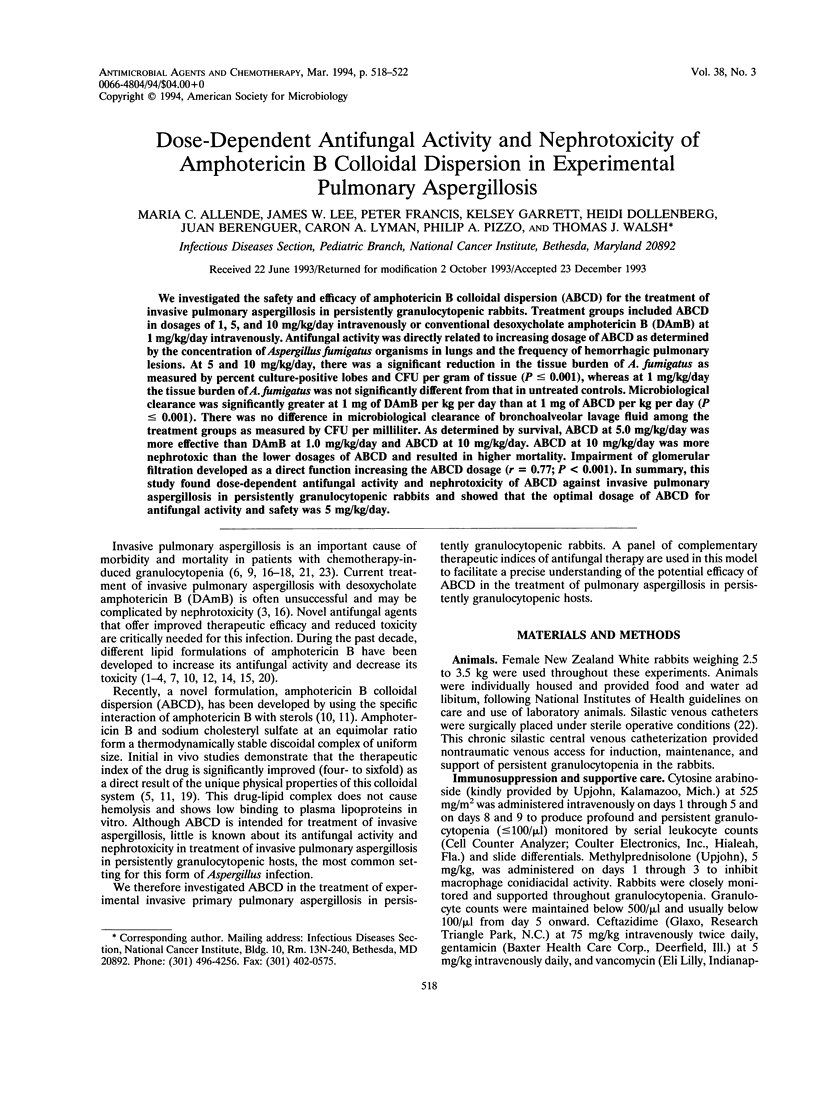
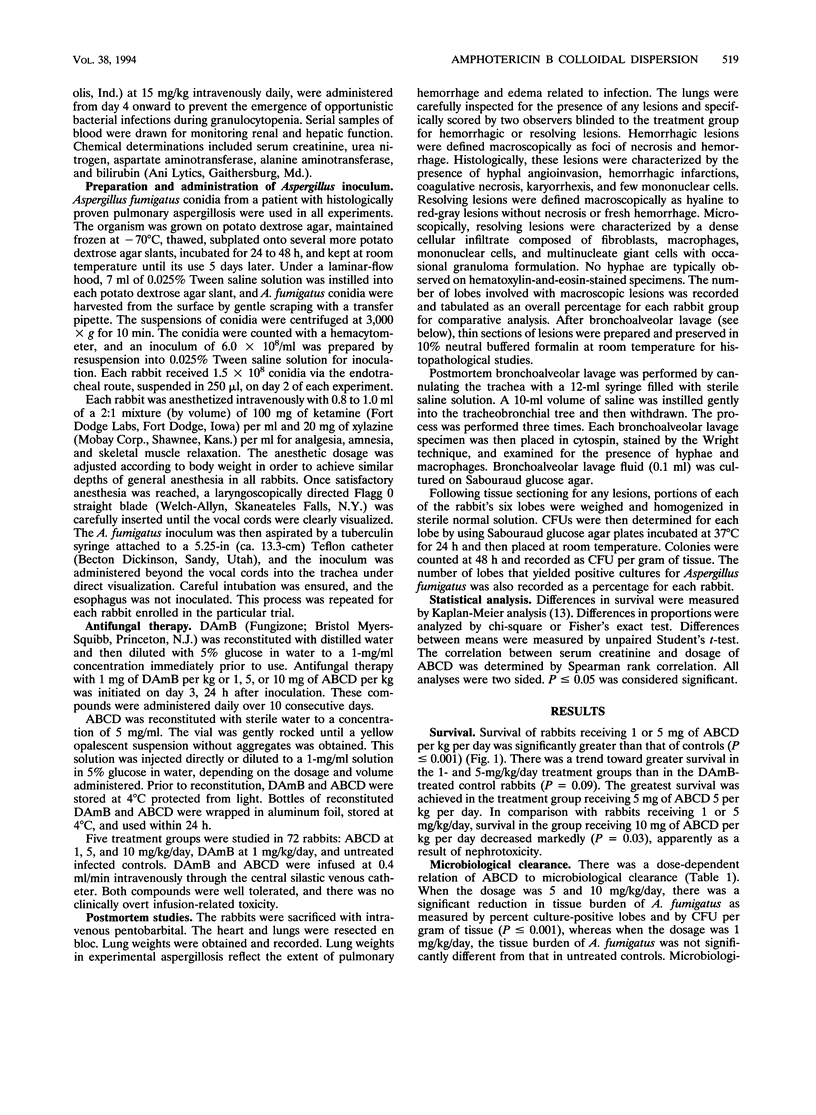
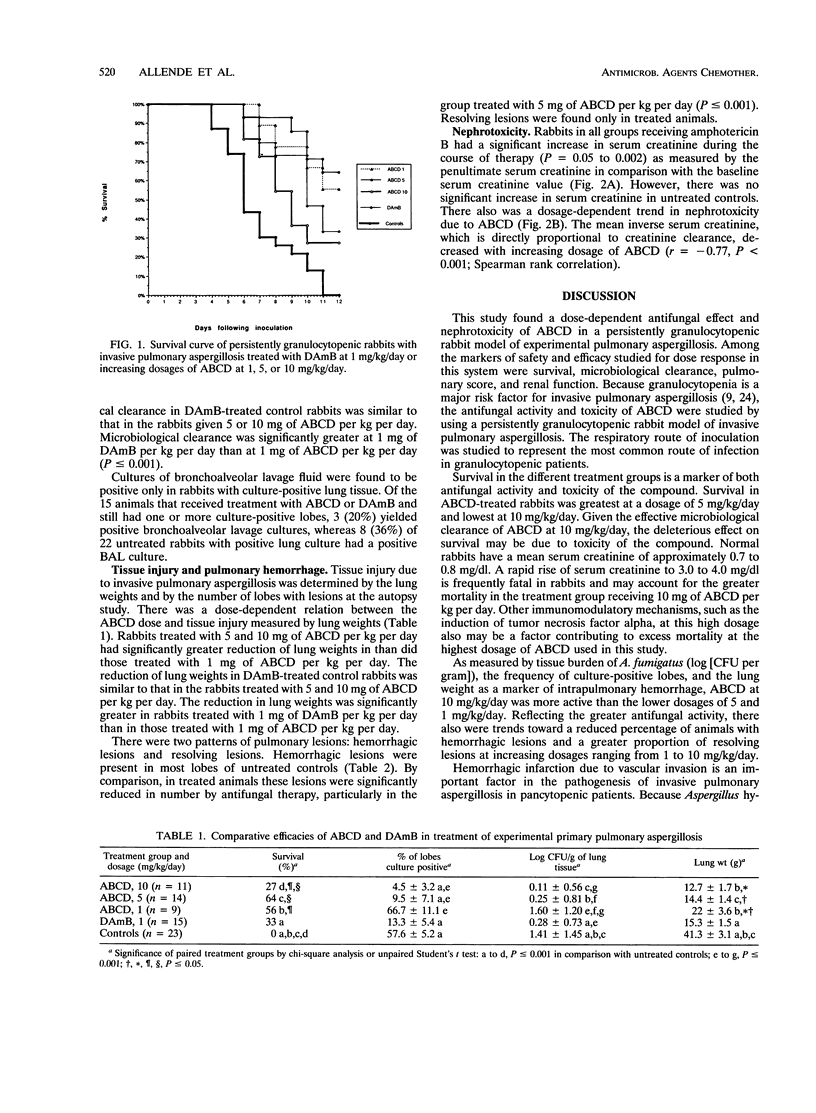
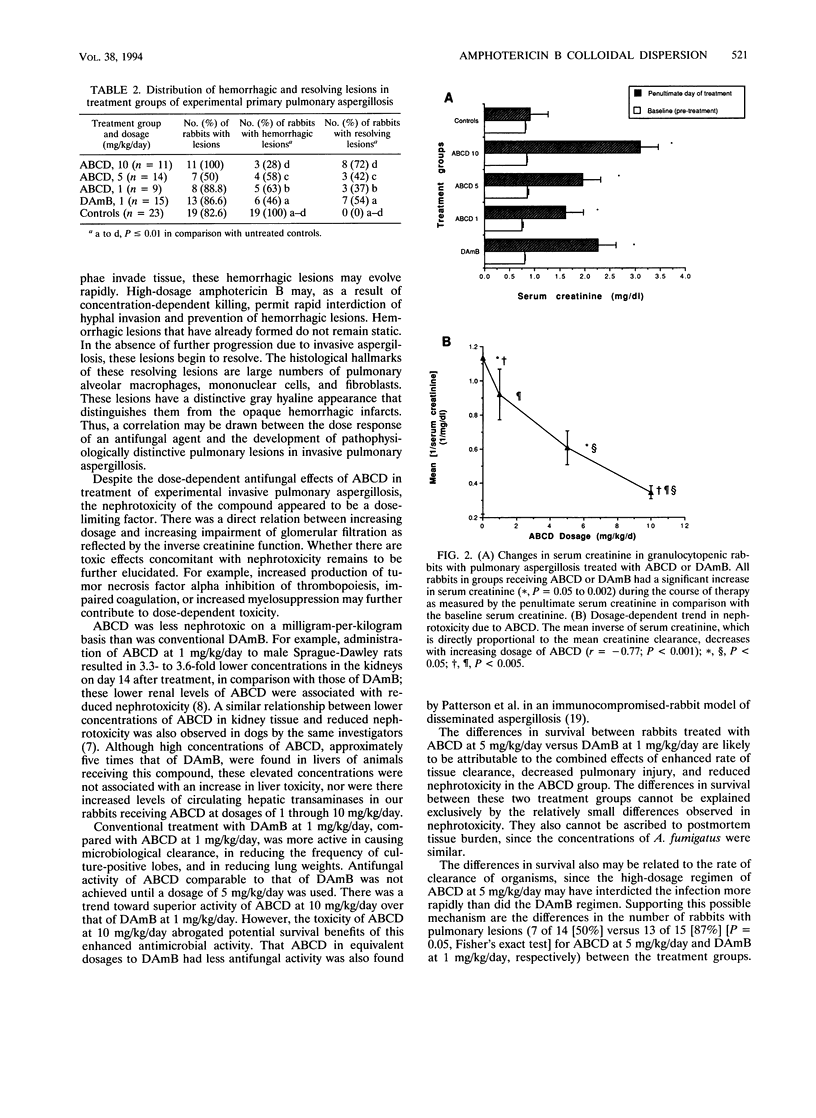
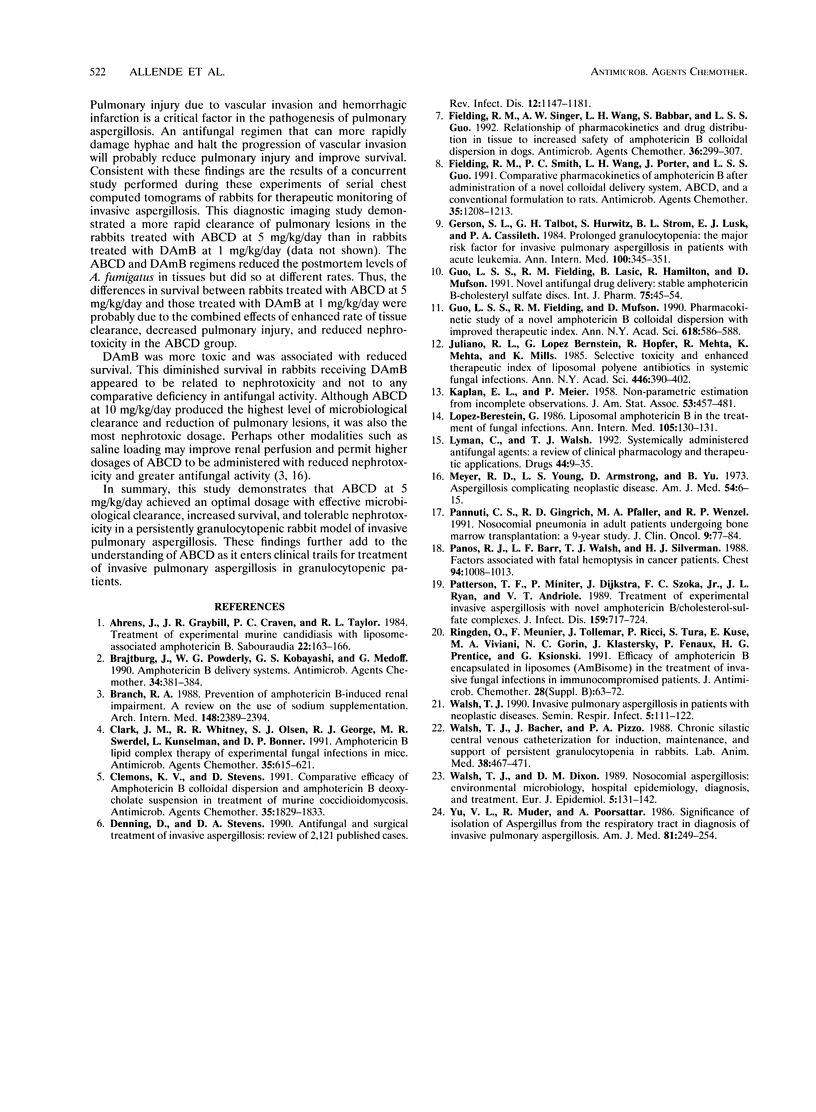
Selected References
These references are in PubMed. This may not be the complete list of references from this article.
- Adler-Moore J. P., Chiang S. M., Satorius A., Guerra D., McAndrews B., McManus E. J., Proffitt R. T. Treatment of murine candidosis and cryptococcosis with a unilamellar liposomal amphotericin B formulation (AmBisome). J Antimicrob Chemother. 1991 Oct;28 (Suppl B):63–71. doi: 10.1093/jac/28.suppl_b.63. [DOI] [PubMed] [Google Scholar]
- Ahrens J., Graybill J. R., Craven P. C., Taylor R. L. Treatment of experimental murine candidiasis with liposome-associated amphotericin B. Sabouraudia. 1984;22(2):163–166. doi: 10.1080/00362178485380251. [DOI] [PubMed] [Google Scholar]
- Brajtburg J., Powderly W. G., Kobayashi G. S., Medoff G. Amphotericin B: delivery systems. Antimicrob Agents Chemother. 1990 Mar;34(3):381–384. doi: 10.1128/aac.34.3.381. [DOI] [PMC free article] [PubMed] [Google Scholar]
- Branch R. A. Prevention of amphotericin B-induced renal impairment. A review on the use of sodium supplementation. Arch Intern Med. 1988 Nov;148(11):2389–2394. [PubMed] [Google Scholar]
- Clark J. M., Whitney R. R., Olsen S. J., George R. J., Swerdel M. R., Kunselman L., Bonner D. P. Amphotericin B lipid complex therapy of experimental fungal infections in mice. Antimicrob Agents Chemother. 1991 Apr;35(4):615–621. doi: 10.1128/aac.35.4.615. [DOI] [PMC free article] [PubMed] [Google Scholar]
- Clemons K. V., Stevens D. A. Comparative efficacy of amphotericin B colloidal dispersion and amphotericin B deoxycholate suspension in treatment of murine coccidioidomycosis. Antimicrob Agents Chemother. 1991 Sep;35(9):1829–1833. doi: 10.1128/aac.35.9.1829. [DOI] [PMC free article] [PubMed] [Google Scholar]
- Denning D. W., Stevens D. A. Antifungal and surgical treatment of invasive aspergillosis: review of 2,121 published cases. Rev Infect Dis. 1990 Nov-Dec;12(6):1147–1201. doi: 10.1093/clinids/12.6.1147. [DOI] [PubMed] [Google Scholar]
- Fielding R. M., Singer A. W., Wang L. H., Babbar S., Guo L. S. Relationship of pharmacokinetics and drug distribution in tissue to increased safety of amphotericin B colloidal dispersion in dogs. Antimicrob Agents Chemother. 1992 Feb;36(2):299–307. doi: 10.1128/aac.36.2.299. [DOI] [PMC free article] [PubMed] [Google Scholar]
- Fielding R. M., Smith P. C., Wang L. H., Porter J., Guo L. S. Comparative pharmacokinetics of amphotericin B after administration of a novel colloidal delivery system, ABCD, and a conventional formulation to rats. Antimicrob Agents Chemother. 1991 Jun;35(6):1208–1213. doi: 10.1128/aac.35.6.1208. [DOI] [PMC free article] [PubMed] [Google Scholar]
- Gerson S. L., Talbot G. H., Hurwitz S., Strom B. L., Lusk E. J., Cassileth P. A. Prolonged granulocytopenia: the major risk factor for invasive pulmonary aspergillosis in patients with acute leukemia. Ann Intern Med. 1984 Mar;100(3):345–351. doi: 10.7326/0003-4819-100-3-345. [DOI] [PubMed] [Google Scholar]
- Juliano R. L., Lopez-Berestein G., Hopfer R., Mehta R., Mehta K., Mills K. Selective toxicity and enhanced therapeutic index of liposomal polyene antibiotics in systemic fungal infections. Ann N Y Acad Sci. 1985;446:390–402. doi: 10.1111/j.1749-6632.1985.tb18416.x. [DOI] [PubMed] [Google Scholar]
- Lopez-Berestein G. Liposomal amphotericin B in the treatment of fungal infections. Ann Intern Med. 1986 Jul;105(1):130–131. doi: 10.7326/0003-4819-105-1-130. [DOI] [PubMed] [Google Scholar]
- Lyman C. A., Walsh T. J. Systemically administered antifungal agents. A review of their clinical pharmacology and therapeutic applications. Drugs. 1992 Jul;44(1):9–35. doi: 10.2165/00003495-199244010-00002. [DOI] [PubMed] [Google Scholar]
- Meyer R. D., Young L. S., Armstrong D., Yu B. Aspergillosis complicating neoplastic disease. Am J Med. 1973 Jan;54(1):6–15. doi: 10.1016/0002-9343(73)90077-6. [DOI] [PubMed] [Google Scholar]
- Pannuti C. S., Gingrich R. D., Pfaller M. A., Wenzel R. P. Nosocomial pneumonia in adult patients undergoing bone marrow transplantation: a 9-year study. J Clin Oncol. 1991 Jan;9(1):77–84. doi: 10.1200/JCO.1991.9.1.77. [DOI] [PubMed] [Google Scholar]
- Panos R. J., Barr L. F., Walsh T. J., Silverman H. J. Factors associated with fatal hemoptysis in cancer patients. Chest. 1988 Nov;94(5):1008–1013. doi: 10.1378/chest.94.5.1008. [DOI] [PubMed] [Google Scholar]
- Patterson T. F., Miniter P., Dijkstra J., Szoka F. C., Jr, Ryan J. L., Andriole V. T. Treatment of experimental invasive aspergillosis with novel amphotericin B/cholesterol-sulfate complexes. J Infect Dis. 1989 Apr;159(4):717–724. doi: 10.1093/infdis/159.4.717. [DOI] [PubMed] [Google Scholar]
- Walsh T. J., Bacher J., Pizzo P. A. Chronic silastic central venous catheterization for induction, maintenance and support of persistent granulocytopenia in rabbits. Lab Anim Sci. 1988 Aug;38(4):467–471. [PubMed] [Google Scholar]
- Walsh T. J., Dixon D. M. Nosocomial aspergillosis: environmental microbiology, hospital epidemiology, diagnosis and treatment. Eur J Epidemiol. 1989 Jun;5(2):131–142. doi: 10.1007/BF00156818. [DOI] [PubMed] [Google Scholar]
- Walsh T. J. Invasive pulmonary aspergillosis in patients with neoplastic diseases. Semin Respir Infect. 1990 Jun;5(2):111–122. [PubMed] [Google Scholar]
- Yu V. L., Muder R. R., Poorsattar A. Significance of isolation of Aspergillus from the respiratory tract in diagnosis of invasive pulmonary aspergillosis. Results from a three-year prospective study. Am J Med. 1986 Aug;81(2):249–254. doi: 10.1016/0002-9343(86)90259-7. [DOI] [PubMed] [Google Scholar]


